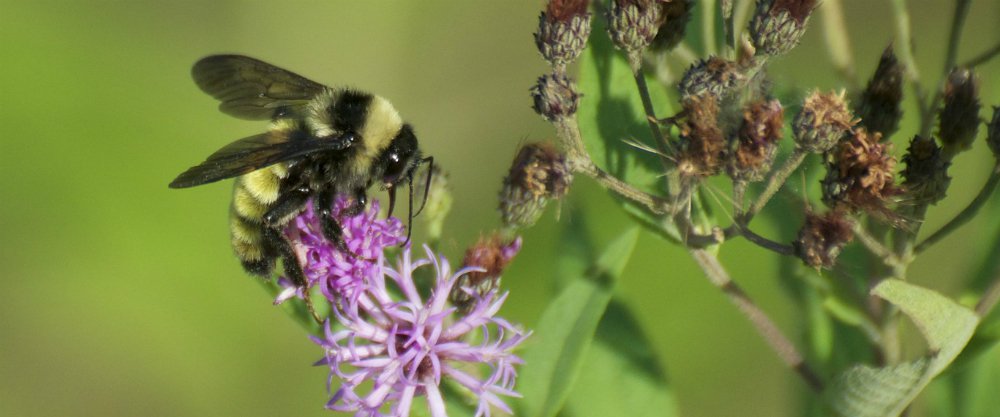Targeting Effective and Efficient Pollinators
The majority of flowering plant species require animals to transport pollen grains among receptive flowers to facilitate pollination and produce viable seed. Potential pollinators include ants, bats, bees, beetles, butterflies, flies, hummingbirds, moths, and wasps. Pollination and the formation of viable seed are critical for the perpetuation of native plant populations. In addition, the berries, nuts, pods, and other fruit produced through pollination can serve as important food resources for a diverse array of animals including birds, insects, reptiles, and mammals. Because pollinators play such a significant role in plant reproduction as well as production of plant-based foods for other species, practices that benefit native pollinators should be a component of any wildlife management plan.
Bees and Pollen

Leafcutter bee. Courtesy of Jessica Womack.
Animal-pollinated plants generally entice potential pollinators through showy flowers that offer rewards in the form of nectar and pollen. Nectar, composed of sugars and other compounds, is an important energy source for many flower-visiting species. Some flower-visiting animals, such as butterflies, hummingbirds, and moths, visit flowers only to feed on sugar-rich nectar. Pollen represents a source of protein and fats for a smaller subset of flower-visitors. Bees, while also feeding on nectar, are one of the few flower-visitors that purposefully forage for pollen, collecting, and transporting it as a food source for their young.
Bees rely upon pollen as a protein source for their developing larvae. Specialized pollen-collecting hairs or other pollen-carrying structures on their bodies enable adult female bees to gather and transport large amounts of pollen to their nest. Much of this gathered pollen will be consumed by their larvae, but bees are vigorous foragers and inadvertently drop or rub pollen off of their bodies as they move from flower to flower.

Leafcutter bee. Courtesy of Cullen Hanks.
During a single day, a female bee may visit several hundred flowers, transferring pollen along the way. Additionally, bees have floral preferences and may concentrate their efforts during any given foraging trip on a certain species of flower in bloom. By focusing in on a single species or subset of species, female bees deliver the right pollen to the right flower. Compared to those animals that lack dedicated pollen-carrying structures or that don't forage specifically for pollen, bees are much more efficient and effective at transferring pollen among flowers.
Native vs. Non-Native Bees
Over 3,500 species of native bee species and roughly 30 non-native bee species have been recorded from North America north of Mexico. Explore bee diversity here: BugGuide: Bees. The European honey bee is the most familiar and well-known non-native bee species in North America. Brought here in the early 1600s, honey bees now occur nearly continent-wide in the form of feral and managed colonies. The honey bee's status as a managed and easily transported insect has made this single bee species the most important pollinator of dozens of U.S. agricultural crops valued in the billions of dollars annually.
While certainly invaluable from an agricultural perspective, honey bees are not a native component of North American natural communities and could negatively impact those systems through competition for foraging resources, disease transmission to native bees, or other means. Beyond native pollinators, there is evidence that some cavity-nesting birds compete for nest sites with feral honey bee colonies, to their detriment. Due to its non-native status and potential impacts on natural communities, the honey bee is more appropriately managed as a semi-free ranging agricultural animal and not as a component of native wildlife or within the context of a wildlife management plan.

American bumble bee. Courtesy of Jessica Womack.
The number of native bee species in Texas vastly outnumbers non-native species. Native bees display an incredible range of shapes, sizes, colors, and lifestyles. An accurate tally of the native bees that occur in Texas is not yet available but a conservative estimate suggests that over 700 native bee species occur here. Native bees are generally the most efficient and effective pollinators of native plants and thus critical to the maintenance of Texas' natural communities. In fact, many native plants can only be pollinated by native bees or other native pollinators. Native bees are also very effective pollinators of many agricultural crops. Several crops, including blueberries, melons, squashes, and tomatoes, are more effectively pollinated by native bees than by honey bees. The annual value of native bee pollination to U.S. agriculture is estimated to be $3 billion (The Economic Value of Ecological Services Provided by Insects).
Crafting a wildlife management plan that meets the needs of native bees is ideal for maintaining a robust population of native flowering plants on your property. At the same time, a wide variety of other pollinators will be supported by management activities that provide the food resources needed by bees. For more details, see Management Recommendations for Native Insect Pollinators in Texas.